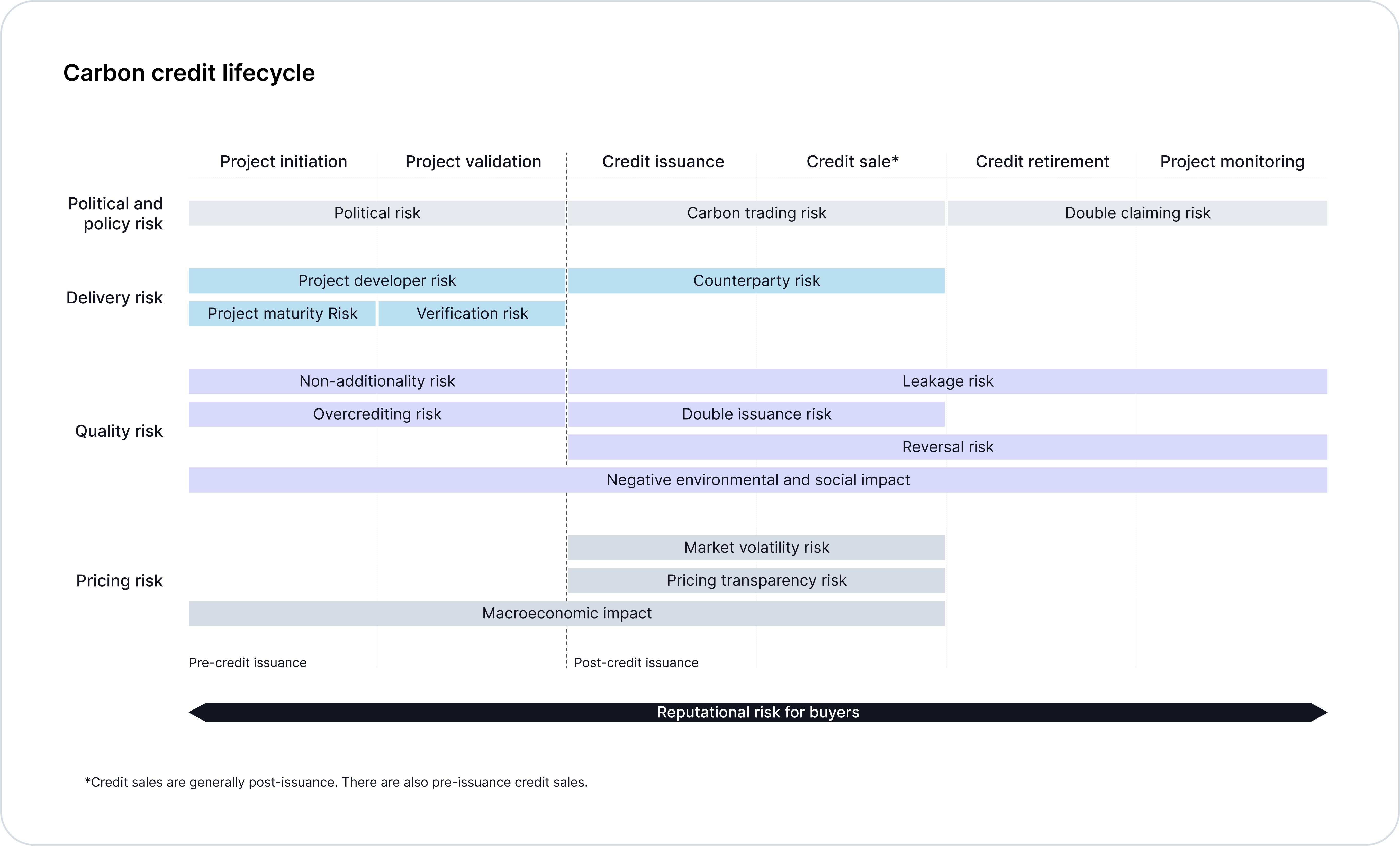This knowledge piece features a PDF version. Download it here.
The carbon market requires a deeper understanding of carbon credit quality risk as well as other risks to scale and provide meaningful climate action. Even after a turbulent year, companies reaffirmed their commitments to their net-zero goals by purchasing and retiring a record 164 million of carbon credits in 2023. To enable exponential growth in the carbon market, a mature market infrastructure is needed.
Integration of market-wide rating agencies like BeZero in procurement and trading platforms help buyers make informed decisions and invest in high-quality credits that truly benefit the planet. There’s a need for a holistic view of all types of risk involved in a carbon credit purchase. CEEZER solves this by providing a top-tier risk balanced portfolio approach, which is powered by its own due diligence process, independent ratings, direct relationships with vetted project developers and pricing information from stakeholders across the globe. Exposure to delivery risk and price risk can be substantial without this type of system.
This knowledge piece, co-authored by BeZero and CEEZER, explores the nature of risk across the carbon market and the emerging tools and data in place to help buyers make informed, effective decisions about their carbon credit investments, to in turn scale climate impact and environmental action.
Inherent risk in the carbon market and the evolving nature of best practices
Carbon credits are necessarily based on uncertain methodological assumptions, estimates, and probabilities. As technology and quantification methodologies have improved over time, what was once considered an acceptable practice a decade ago has not held up today. Risk is inherent in the carbon market, just like with most products that can be bought in the market, and no credit is entirely risk-free. The nature and extent of the risk factors related to carbon credits vary depending on the project type, but also on the seller and the transaction timing. To be a savvy, responsible user of carbon credits means understanding and mitigating these risks.
Understanding risk factors
Throughout the lifecycle of a carbon credit, various risk factors come into play, including project quality, credit delivery, the political climate of the host country, and the fluctuating price of credits. Given the array of risks involved and their reputations at stake, buyers often approach the acquisition of carbon credits with trepidation. The requisite due diligence, both initial and ongoing, can be costly and time consuming.

In 2023, the carbon market experienced notable market volatility, primarily due to intensified scrutiny over the quality of certain carbon credits. Projects under the spotlight witnessed dramatic price drops, in some cases exceeding 50% decrease, driven by massive sell-offs and low demand. Conversely, there’s a clear trend of buyers favoring high-quality projects, which tend to exhibit less price volatility, indicating a reduced risk in terms of pricing. However, it’s crucial to note that delivery risk alone doesn’t necessarily correlate with project quality. Generally, spot credits are seen as lower risk, while forward credits, particularly from emerging removal projects which are yet to issue credits, carry higher delivery risk. Despite this, these innovative projects often offer greater permanence and potential higher climate impact, presenting a compelling proposition for those looking to invest in the future of climate solutions.
Carbon credits are intangible, meaning there is no immediate physical result of your purchase. They are also reductive, in that payments are made to reduce a certain activity. Both qualities exacerbate the informational asymmetry between project developers and end users: the supplier knows far more about the quality and delivery timeline of the project than the purchaser does. Due to the complexity and lack of publicly available documentation, direct contact with project developers can further mitigate risk.
How can buyers balance risk and impact?
It’s essential to recognize that while risk is an important benchmark, it’s not the sole factor to take into account. When designing a carbon credit portfolio of beyond value chain mitigation (BVCM) activities and investments, companies should balance risk with the impact of financing mitigation activities.
For instance, a company may choose to support activities that are more uncertain in terms of the mitigation outcome but which could have cascading positive impacts and deliver long-term systemic change. For example, novel carbon dioxide removal (CDR) methods, despite their relative immaturity and associated risks, present a unique opportunity. When investing in thoughtfully executed pilot-scale projects, these novel approaches can be catalytic, driving necessary innovation and advancing our potential for future climate action. By investing small amounts at an early stage, potential shortfalls such as delivery failure could be mitigated using alternative replacement credits.
Another example could be a company that wants to support activities which contribute to climate justice, for example by channeling finance to countries and communities with lower responsibility for climate change, but with greatest vulnerability to climate change impacts. Investing in underfinanced projects in politically unstable and emerging regions, while associated with certain risks, can yield substantial climate action impacts and bring extensive benefits to local communities.
The key is to be aware of this and purposefully balance the potential impact against the inherent risks. In doing so, consider the following strategies:
1. Invest in projects developed by reputable proponents
Engage with project developers known for their integrity and robust project management. This ensures that projects are not only designed well but also implemented effectively. CEEZER enhances this approach by maintaining close ties with project developers, coupled with a rigorous process to evaluate their delivery capabilities. CEEZER’s insight into the intricacies of carbon financing flows and exclusive access to data not publicly available equip buyers with the comprehensive visibility needed to navigate risks effectively. By doing so, CEEZER not only mitigates risk but also significantly lightens the workload for buyers, ensuring smoother and more secure transactions in the carbon market.
2. Adopt a portfolio approach
Diversify your carbon credit portfolio. Just like in financial markets, diversification in the carbon market can spread risk across different projects, geographies, and project types, ensuring that the overall impact is not compromised by the failure or underperformance of a single project. BeZero Carbon's risk-adjusted portfolio discounting tool assists customers in developing credible carbon credit strategies that are in line with their net zero goals. This enables them to calculate how many credits of a given quality they need to purchase or retire to make a credible tonne-based claim.
3. Invest in carbon insurance
Consider carbon insurance products to mitigate the risks associated with specific projects. This can provide a safety net against unforeseen project failures or market fluctuations. Carbon ratings, such as those published by BeZero, are beginning to be integrated into insurance products to provide market-wide standard measures of risk.
4. Seek multiple perspectives on quality
Don’t rely on a single source of information for project quality. Look for certifications and leverage platforms like CEEZER, which offer reputable ratings like BeZero’s and other data points. Multiple perspectives can provide a more rounded view of the project’s potential and risks.
5. Leverage market convergence
The convergence of voluntary and compliance markets, especially with future adoption of frameworks like Paris Agreement Article 6 and CORSIA, can help mitigate political and policy risk, as well as quality risk. Additionally, as these markets mature and demand stabilizes, price risks can also be reduced. Buyers should continuously monitor regulatory developments and refine their portfolio strategy with emerging themes and updates from independent quality initiatives.
By adopting these strategies, buyers can navigate the carbon market more confidently, balancing the risks with the potential for significant impact. The goal is not to avoid risk entirely but to understand it, manage it, and ensure that every purchase contributes meaningfully to the global fight against climate change.
Independent project ratings by BeZero Carbon
BeZero Carbon is a carbon ratings agency that assesses carbon credit projects all over the world and rates them on an eight-point scale, to determine the likelihood that they will remove or avoid a tonne of carbon. Their ratings scale runs from D, the least likely to remove or avoid carbon, to AAA, the most likely to achieve a tonne of carbon removed or avoided. To date, BeZero has rated nearly 400 carbon credit projects covering every sector, across all stages in the carbon project lifecycle.
In practice, this means BeZero offers not only ex-post ratings (projects that have already issued credits), but also ex-ante ratings (projects in development that have yet to issue any credits). Their ex-ante ratings assess both carbon efficacy and project execution risk. For every dollar transacted in the secondary carbon market, an estimated three to five dollars is invested in the primary market – and it is here that project developers, investors and end buyers fund or agree on large-scale forward purchases of a growing number of projects. The ex-ante ratings give investors the risk assessments and information they need to make informed investments in the primary market, and help them direct capital to where it can have the greatest environmental impact.
Quality and price correlation is beginning to show itself across the market. Recent research by BeZero shows that on average, over the period since the launch of BeZero Carbon ratings in April 2022, there has been a 25% price difference between credits separated by one BeZero rating notch (e.g. ‘C’ and ‘B’ or ‘BBB’ and ‘A’). In recent months, the average price difference between credits separated by one BeZero Carbon rating notch has grown to around 40%, and the average price premium for credits in the higher BeZero Carbon rating categories of ‘A’ or above has risen rapidly to 200%. These trends support the theory that transparent market infrastructure such as ratings will lead to incentives for high quality carbon credit supply.
Mapping risks at a transactional level: CEEZER’s perspective
CEEZER delivers an enterprise platform for companies to screen, purchase and manage high-quality carbon credits based on concrete data. The platform connects vetted project developers with carbon credit purchasers and utilizes rating agencies like BeZero to complement the extensive data provided on market as well as on project level.
With over 3.5 million data points, CEEZER’s platform distinguishes quality, risk, and impact among projects, demystifying the purchase process and simplifying decision-making. These data points include access to basic project information such as standards, methodology, Oxford Principles categorization, verification status, co-benefits or alignment with Sustainable Development Goals (SDGs), and pricing. Moreover, CEEZER offers key data points specific to each project type. These allow for a straightforward comparison between projects within the same category, such as the hydrogen-to-carbon (H:C) Ratio for biochar projects or the fraction of non-renewable biomass (fNRB) value for an improved cookstove project, enhancing the buyer’s ability to make an informed choice.
To support buyer’s decision making on the carbon credit purchases, CEEZER leverages third-party agencies’ analysis on quality risk, political, and policy risk, while offering proprietary insights on delivery risk and price risk, to paint a fuller picture on the risk profile of the project and each transaction. Specifically, delivery risk and price risk are uniquely tied to each transaction, due to varying factors such as vintage, contract type or counterparty. CEEZER’s first-hand knowledge of the project developers, combined with historical transaction data and current market intelligence, ensure a high level of transparency regarding each credit’s risk profile.
Conclusion: Championing high-quality carbon credits
Still in its adolescence, the carbon market is fragmented and can be hard to navigate. Companies looking to invest in carbon credits should rely on third-party due diligence before purchasing credits directly. Buyers who use procurement platforms like CEEZER, integrated with independent rating agencies like BeZero, can champion high-quality carbon credits while efficiently managing risk in their carbon credit procurement strategy. This significantly reduces internal resources in procuring the credit portfolio. It is important to take a holistic approach to assess the full range of risk involved in every carbon credit procurement strategy. More data, more transparency means that high-quality carbon credits will surface. This will also be driven by pricing – with trends already showing that higher-quality credits are demanding greater price premiums, greater transparency and better data.
Contributors
- Lucas van Doorn, Senior Impact Manager at CEEZER
- Shanshan He, Carbon Finance Expert at CEEZER
- Spencer Meyer, PhD, VP Ratings at BeZero
About
- BeZero Carbon is a carbon ratings agency. Its ratings and risk products equip world-leading organizations with the knowledge, tools and confidence to make better climate decisions. Its aim is to scale investment in environmental markets that deliver a sustainable future. To learn more please reach out or book a demo today.
- CEEZER is the digital platform that provides enterprises with easy, secure, and direct access to high-quality projects from the entire carbon credit market. Leading corporations use the platform to screen, purchase, and manage carbon credit portfolios to accelerate climate action. With more than 3.5 million data points, CEEZER brings transparency to the carbon market by connecting project developers and enterprises worldwide without intermediaries or hidden fees. For more information, get in touch here or book a demo today.
➔ The full version of this knowledge piece is available as PDF. Download it here.






